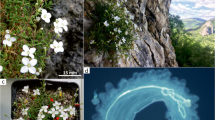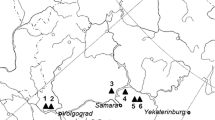Abstract
Genetic differentiation at the morphological, isozyme, and DNA levels among sevenDasypyrum villosum (Poaceae, Triticeae, 2n = 14, VV genomes) populations from Italy was studied. A measure of the mating system was also obtained. Genetic diversity was mainly distributed within populations (90%) rather than among populations (10%), typical for most allogamous species. Interpopulation diversity, however, was greatest between the most geographically distant populations (about 750 km apart, 911 m altitude difference). The mating system was estimated to vary from 55 to 100% outcrossing. One population (I-16, Bomarzo) deviated from the others in its uniform early flowering habit and presence of isozyme alleles not found in other populations. It had genetic diversity similar to other populations for isozyme (Got-V2, Got-V3, andEst-VF) and ribosomal RNA (Nor-Vl) loci. This population is believed to be the product of a few migrant founder seeds and its unique characters point out that generalized population biology parameters of genetic diversity are not sufficient for describing species variation nor for developing conservation strategies.
Similar content being viewed by others
References
Allard, R. W., 1975: The mating system and microevolution. — Genetics79: 115–126.
, 1972: Evidence for coadaptation inAvena barbata. — Proc. Natl. Acad. Sci. USA69: 3043–3048.
Barber, H. N., Driscoll, C. J., Long, P. M., Vickery, R. S., 1968: Protein genetics of wheat and homoeologous relationships of chromosomes. — Nature218: 450–452.
, 1969: Gene similarity of theTriticinae and the study of segmental interchanges. — Nature222: 897–898.
Blanco, A., Perrone, V., Resta, P., 1987: The addition ofDasypyrum villosum (L.)Candargy chromosomes todurum wheat (Triticum durum Desf.). — Theor. Appl. Genet.74: 328–333.
, 1988: Chromosome pairing variation inTriticum turgidum L. ×Dasypyrum villosum (L.)Candargy hybrids and genome affinities. — InMiller, T. E., Koebner, R. M. D., (Eds): Proc. Seventh Int. Wheat Genet. Symp.1, pp. 63–67. — Cambridge: Institute of Plant Science Research.
Brown, A. H. D., 1979: Enzyme polymorphism in plant populations. — Theor. Pop. Biol.15: 1–42.
Clegg, M. T., Allard, R. W., 1972: Patterns of genetic differentiation in the slender wild oat speciesAvena barbata. — Proc. Natl. Acad. Sci. USA69: 1820–1824.
Dellaporta, S. L., Wood, J., Hicks, J. B., 1983: A plant DNA minipreparation: version II. — Pl. Mol. Biol. Reporter1: 19–21.
Delre, V., De Pace, C., Maggini, F., Scarascia Mugnozza, G. T., Qualset, C. O., 1988: Ribosomal DNA spacer length polymorphism inDasypyrum villosum populations. — InMcGuire, P. E., (Ed.): Population genetics and germplasm resources in crop improvement. Report No.3: 43. — Davis, CA: Genetic Resource Conservation Program, University of California.
De Pace, C., 1987: Genetic variability in natural populations ofDasypyrum villosum (L.)Candargy. — Ph.D. Thesis, University of California, Davis.
, 1988a: Biochemical markers inTriticum ×Dasypyrum amphiploids and derived disomic addition lines. — InMiller, T. E., Koebner, R. M. D., (Eds): Proc. Seventh Int. Wheat Genet. Symp.1: 503–590. — Cambridge: Institute of Plant Science Research.
, 1988b: Biochemical versatility of amphiploids derived from crossingDasypyrum villosum Candargy and wheat; genetic control and phenotypical aspects. — Theor. Appl. Genet.76: 513–529.
, 1992: Molecular and chromosomal characterization of repeated and singlecopy DNA sequences in the genome ofDasypyrum villosum. — Hereditas116: 55–65.
Dvorak, J., 1989: Evolution of multigene families: the ribosomal RNA loci of wheat and related species. — InBrown, A. H. D., Clegg, M. T., Kahler, A. L., Weir, B. S., (Eds): Plant population genetics, breeding, and genetic resources, pp. 83–97. — Sunderland, Massachusetts: Sinauer.
Falconer, D. S., 1960: Introduction to quantitative genetics. — London: Longman.
Frederiksen, S., 1991: Taxonomic studies inDasypyrum (Poaceae). — Nordic J. Bot.11: 135–142.
Gill, B. S., Appels, R., 1988: Relationships betweenNor loci from differentTriticeae species. — Pl. Syst. Evol.160: 77–89.
Hamrick, J. L., Allard, R. W., 1972: Microgeographical variation in allozyme frequencies inAvena barbata. — Proc. Natl. Acad. Sci. USA69: 2100–2104.
, 1989: Allozyme diversity in plant species. — InBrown, A. H. D., Clegg, M. T., Kahler, A. L., Weir, B. S., (Eds): Plant population genetics, breeding, and genetic resources, pp. 43–63. — Sunderland, Massachusetts: Sinauer.
Hedrick, P. W., 1971: A new approach to measuring genetic similarity. — Evolution25: 276–280.
, 1975: Genetic similarity and distance: comments and comparisons. — Evolution29: 362–366.
Hillel, J., Feldman, M. W., Sinclair, G., 1973: Mating systems and population structure in two closely related species of the wheat group. I. Variation between and within populations. — Heredity30: 141–167.
Hyde, B. B., 1953: Addition of individualHaynaldia villosa chromosomes to hexaploid wheat. — Amer. J. Bot.40: 174–182.
Humphries, C. J., 1978:Dasypyrum (Cosson & Durieu)T. Durand. — InHeywood, V. H., (Ed.): Flora europaea. Notulae systematicae ad floram europaeam spectantes. N° 20. — Bot. J. Linn. Soc.76: 297–384.
Jaaska, V., 1975: Evolutionary variation of enzymes and phylogenetic relationships in the genusSecale L. — Eesti Nsv. Tead. Akad. Toim. Biol.24: 179–198 (in Russian with English summary).
, 1982: Isoenzymes of superoxide dismutase in wheats and their relatives: alloenzyme variation. — Biochem. Physiol. Pfl.177: 747–755.
Jain, S. K., 1979: Estimation of outcrossing rates: some alternative procedures. — Crop. Sci.19: 23–26.
Jan, C. C., De Pace, C., McGuire, P. C., Qualset, C. O., 1986: Hybrids and amphiploids ofTriticum aestivum L. andT. turgidum L. withDasypyrum villosum (L.)Candargy. — Z. Pflanzenzücht.96: 97–106.
Johnson, G. B., 1976: Genetic polymorphism and enzyme function. — InAyala, J., (Ed.): Molecular evolution, pp. 46–59. — Sunderland, Massachusetts: Sinauer.
Kahler, A. L., Allard, R. W., Krzakowa, M., Wehrhahn, C. F., Nevo, E., 1980: Associations between isozyme phenotypes and environment in the slender wild oat (Avena barbata) in Israel. — Theor. Appl. Genet.56: 31–47.
Lewontin, R. C., 1972: The apportionment of human diversity. — Evol. Biol.6: 381–398. — New York: Appleton Century-Craft.
Linde-Laursen, I., Frederiksen, S., 1991: Comparison of the Giemsa C-banded karyotypes ofDasypyrum villosum (2×) andD. breviaristatum (4×) from Greece. — Hereditas114: 237–244.
Liu, D. J., Chen, P. D., Pei, G. Z., Wang, Y. N., Qiu, B. X., Wang, S. L., 1988: Transfer ofHaynaldia villosa chromosomes intoTriticum aestivum. — InMiller, T. E., Koebner, R. M. D., (Eds): Prov. Seventh Int. Wheat Genet. Symp.1: 355–361. — Cambridge: Institute of Plant Science Research.
Löve, A., 1984: Conspectus of theTriticeae. — Feddes Repert.95: 425–521.
MacDonald, T., Brewbaker, J. L., 1974: Isoenzyme polymorphism in flowering plants. IX. The E5–E10 esterase loci of maize. — J. Heredity65: 37–42.
Mantel, N., 1967: The detection of disease clustering and a generalized regression approach. — Cancer Res.27: 209–220.
McIntyre, C. L., 1988: Variation at isozyme loci inTriticeae. — Pl. Syst. Evol.160: 123–142.
Montebove, L., De Pace, C., Jan, C. C., Qualset, C. O., Scarascia Mugnozza, G. T., 1987: Chromosomal location of isozyme and seed storage protein genes inDasypyrum villosum Candargy. — Theor. Appl. Genet.73: 836–845.
Nei, M., 1972: Genetic distance between populations. — Amer. Naturalist106: 283–292.
, 1973: Analysis of gene diversity in subdivided populations. — Proc. Natl. Acad. Sci. USA70: 3321–3323.
, 1977: F-statistics and analysis of gene diversity in subdivided populations. — Ann. Hum. Genet.41: 225–233.
Nevo, E., Zohary, D., Brown, A. H. D., Harber, M., 1979: Genetic diversity and environmental associations of wild barley,Hordeum spontaneum, in Israel. — Evolution33: 815–833.
, 1982: Genetic diversity and environmental associations of wild wheat,Triticum dicoccoides, in Israel. — Theor. Appl. Genet.62: 241–254.
, 1983: Microgeographic edaphic differentiation in hordein polymorphisms of wild barley. — Theor. Appl. Genet.64: 123–132.
Qualset, C. O., Zhong, G. Y., De Pace, C., McGuire, P. E., 1993: Population biology and evaluation of genetic resources ofDasypyrum villosum. — InDamania, A. B., (Ed.): Biodiversity and wheat improvement, pp. 227–233. — Chicester: Wiley.
Ritland, K. M., Jain, S. K., 1981: A model for the estimation of outcrossing rate and gene frequencies using N independent loci. — Heredity46: 35–52.
Sakamoto, S., 1986: Genome analysis of polyploid form ofHaynaldia hordeacea in the tribeTriticeae, Gramineae. — Proc. 1st Int. Symp. Chromosome Engineering in Plants, pp. 52–53. — Xian, China.
Sando, W. J., 1935: Intergeneric hybrids ofTriticum andSecale withHaynaldia villosa. — J. Agric. Res.51: 759–800.
Sarkar, P., 1957: A new diploid form ofHaynaldia hordeacea Hack. — Wheat Inf. Serv.6: 22.
Schmidt-Stohn, G., Wehling, P., 1983: Genetic control of esterase isoenzymes in rye (Secale cereale L.). — Theor. Appl. Genet.64: 109–115.
Schwartz, D., 1960: Genetic studies on mutant enzymes in maize. Synthesis of hybrid enzymes by heterozygotes. — Proc. Natl. Acad. Sci. USA46: 1210–1216.
Sears, E. R., 1953: Addition of the genome ofHaynaldia villosa toTriticum aestivum. — Amer. J. Bot.40: 168–174.
Shaw, D. W., Kahler, A. L., Allard, R. W., 1981: A multilocus estimator of mating system parameters in plant populations. — Proc. Natl. Acad. Sci. USA78: 1298–1302.
Smouse, P. E., Long, J. C., Sokal, R. R., 1986: Multiple regression and correlation extensions of the Mantel test of matrix correspondence. — Syst. Zool.35: 627–632.
Templeton, A. R., 1980: The theory of speciation via the founder principle. — Genetics94: 1011–1038.
Vapa, L., Kastori, R., Filipovic, S., 1993: Genetic variability of proteins inDasypyrum villosum populations. — J. Genet. Breed.47: 49–52.
Wright, S., 1942: Statistical genetics and evolution. — Bull. Amer. Math. Soc.48: 223–246.
, 1943: Isolation by distance. — Genetics28: 114–138.
, 1946: Isolation by distance under diverse systems of mating. — Genetics31: 39–59.
, 1951: The genetical structure of populations. — Ann. Eugenics15: 323–354.
Yaghooby-Saray, J., 1979: An electrophoretic analysis of genetic variation within and between populations of five species in theTriticum aegilops complex. — Ph.D. Thesis, University of California, Davis.
Zhong, G.-Y., Qualset, C. O., 1990: An alternative method for assigning genes to specific chromosomes ofDasypyrum villosum (L.)Candargy. — InKimber, G., (Ed.): Proc. Second Int. Symp. Chromosome Engineering in Plants, pp. 302–309. — Columbia: University of Missouri Press.
, 1993: Allelic diversity of high-molecular-weight glutenin protein subunits in natural populations ofDasypyrum villosum (L.)Candargy. — Theor. Appl. Genet.86: 851–858.
- - 1995: Quantitative genetic diversity and conservation strategies for an allogamous annual species,Dasypyrum villosum (L.)Candargy. — Theor. Appl. Genet. (in press).
Author information
Authors and Affiliations
Rights and permissions
About this article
Cite this article
De Pace, C., Qualset, C.O. Mating system and genetic differentiation inDasypyrum villosum (Poaceae) in Italy. Pl Syst Evol 197, 123–147 (1995). https://doi.org/10.1007/BF00984637
Received:
Revised:
Accepted:
Issue Date:
DOI: https://doi.org/10.1007/BF00984637




